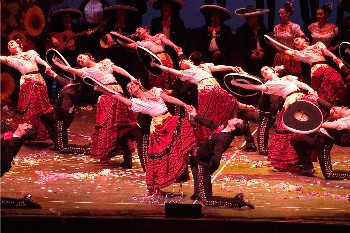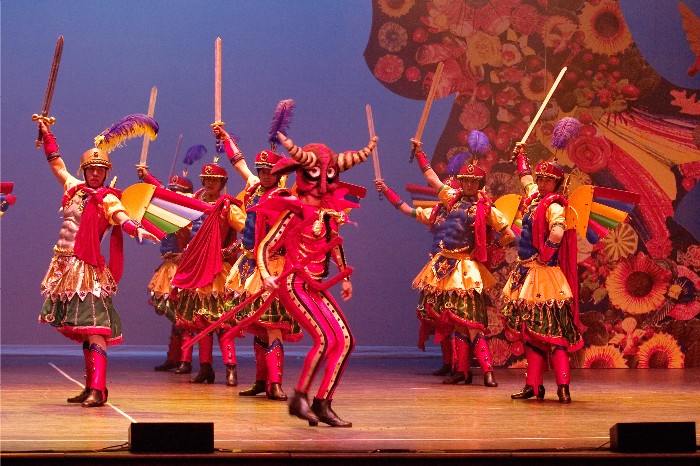Dance Review: Viva Ballet Folklórico de México!
No question that the culture of Mexico is suffused with memories of music, bright colors, and joy. Would that contemporary political realities reflected more closely the life-enhancing images on stage.
Ballet Foklórico de México. Presented by World Music. At Citi Shubert Theatre, September 22.
By Iris Fanger
If only Mexico were as consistently enchanting as the stages pictures created by Ballet Folklórico de México! The performance at the Shubert Theatre was a one night only stand before the company set off on its U.S. tour. Imagine smiling, virile young men stamping in serpentine, unison patterns while their peacock-like women twirled around them -— 30 dancers in all. Everyone is smiling. When they carry rifles -— women as well as men in a sequence based on the 1910 Revolution -— they are props used to extend their gestures further into space. The long knives are used only once, in combat between rivals for a bride. Once the corpse is dragged off, the dancing starts up again.
Perhaps when Ballet Folklórico de México was founded in 1952 by Amalia Hernandez, the days and nights in Mexico were indeed filled with gaiety, peace, and a rough sort of prosperity -— even for the peasants. There was little then of what makes for headlines in America today: the trauma of immigrants struggling to breach the U.S. border and the barbaric violence of the drug wars. In performance, the upbeat spectacle by Ballet Folklórico comes across as a lively (and ironic) dream of what might have been.
The troupe’s presentation is a throw back to the decades when Boston was a touring stop for folk-dance companies such as the Moiseyev from Russia as well as numerous groups representing nations throughout Africa and Asia. These companies brought glimpses of the music and dance of their countries: the performers, garbed in eye-popping costumes, performed choreographed rituals of daily life, spectacular pieces about weddings, harvests, and warriors going off to battle.
Ballet Folklórico de México brought a similar assortment of works, including a dance originating in the legend of the quetzal bird, “The Quetzals of Puebla,” which reaches as far back as King Montezuma. The 15 male performers wore huge headdresses constructed from squares of colored glass set in half-circular frames atop cone-shaped hats. The men moved in a hopping, complex stepping line dance, a repetitive series of measures that reverberated through the space. A stunning male solo, “The Deer Dance,” was performed in leaps and pawing gestures that captured the movements of a frightened animal trying to escape his hunter.
Another work had the women wearing dresses in the style of the 1890s (they looked like figures from Agnes de Mille’s choreography for the dream ballet in Oklahoma) to dance the polka with men sporting the stylish frock coats and pants of the period. The men in “Revolution” were dressed Viva Zapata style in white pants and shirts, with straw sombreros. The women toting the rifles also wore belts of bullets slung across their chest, over satiny, multi-colored blouses and peasant skirts. (The work reminded me of the Chinese classic, “Red Detachment of Women,” which features a corps de ballet of women on pointe, with rifles at the ready.)
In general, the women’s movements for Ballet Folklórico drew on the Flamenco tradition. But the tone of their performances evoked constant gaiety rather than the passion and tragedy of the Spanish dance. The ruffled skirts of the Mexican costumes were held out at arm’s length and swished up and down, in and out, in what used to be called “skirt dancing” on the nineteenth-century stage. The women also moved their shoulders up and down, back and forth, sometimes rocking on their heels and ankles, like tiny, lovely dolls. And, of course, the evening ended in the Mexican Hat Dance, the performers tossing coils of confetti into the audience.
One of the most pleasing aspects of the evening was the live musical accompaniment by 11 musicians on violins, guitars, a harp, and three trumpets, the latter added at the end for the Mariachis band. The musicians also sang, often hitting throbbing, high notes held seemingly for an eternity, a skill the audience appreciated highly. No question that the culture of Mexico is suffused with memories of music, bright colors, and joy. Would that contemporary political realities reflected more closely the life-enhancing images on stage.


